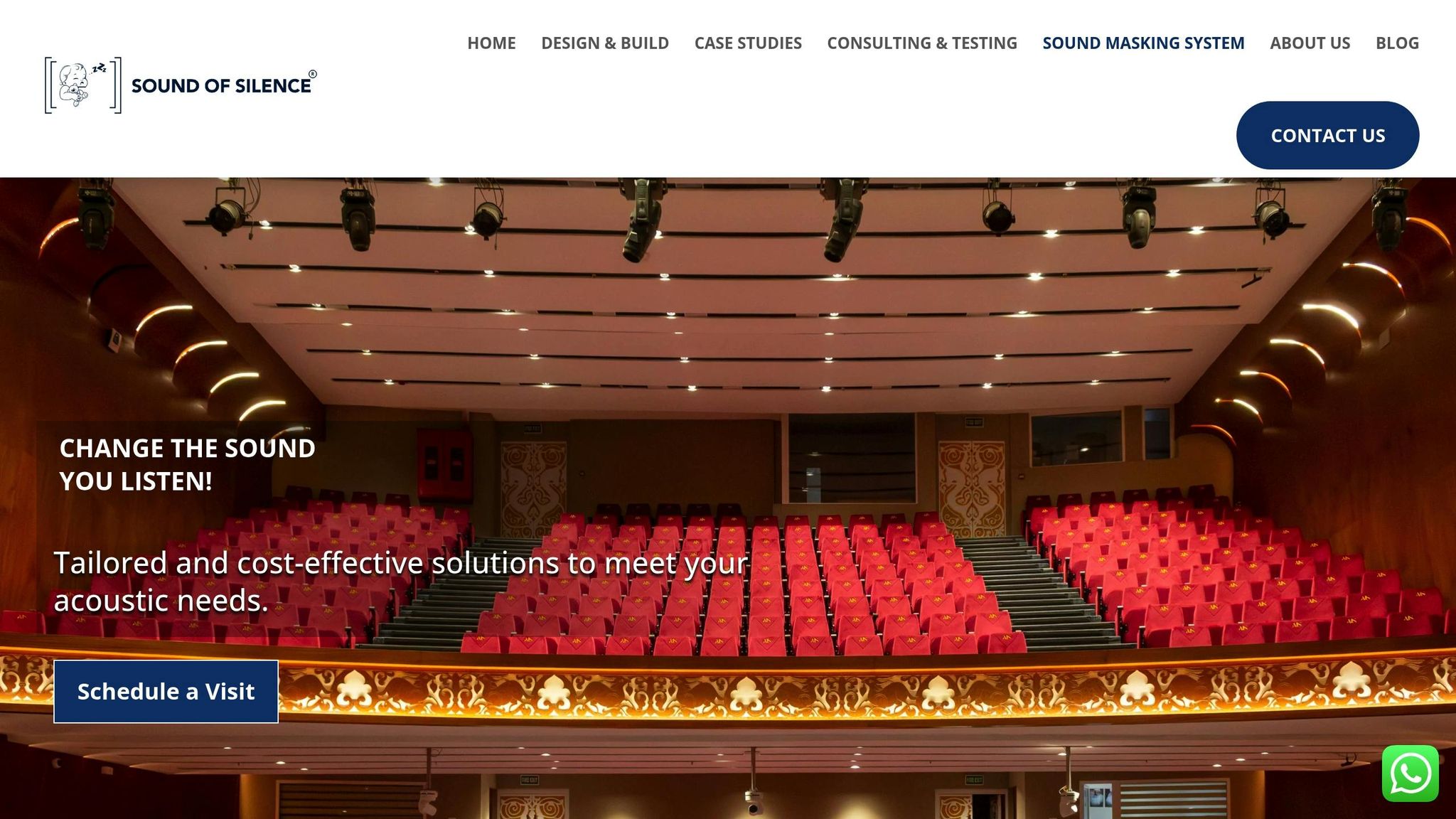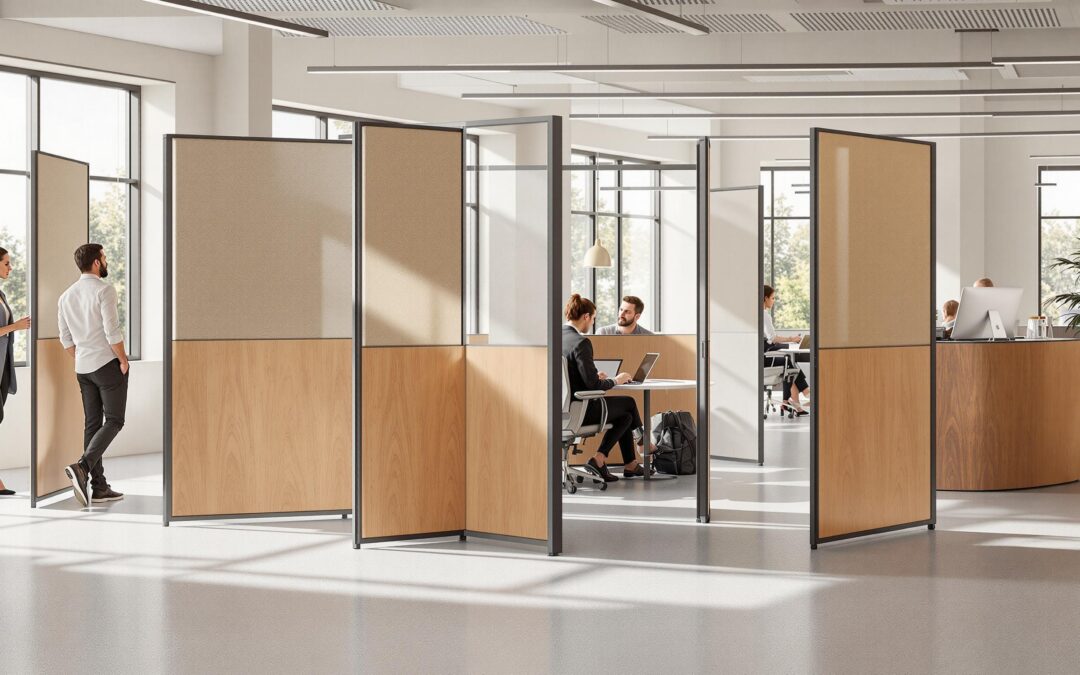Movable acoustic partitions are a practical way to divide spaces while reducing noise. They are designed to create flexible layouts in offices, schools, event venues, and more, without permanent structural changes. Here’s why they matter:
- Sound Control: Reduce noise transfer and maintain privacy.
- Flexible Layouts: Quickly reconfigure spaces for different uses.
- Custom Designs: Match aesthetics while improving functionality.
- Ease of Use: Options include manual, semi-automatic, and fully automatic systems.
These partitions are ideal for creating private meeting rooms in offices, dividing classrooms in schools, or transforming large event spaces into smaller sections. Proper installation, sound rating selection (STC), and maintenance ensure they work effectively.
For a reliable solution, consult experts like Sound of Silence, who specialise in acoustic consulting, testing, and installation tailored to your specific needs.
Main Advantages
Space Management
Movable acoustic partitions make it easier to organise multi-purpose spaces. They allow large areas to be divided into smaller, task-specific sections. This setup helps minimise downtime between events and ensures better use of available space. Plus, they contribute to improved acoustic performance when reconfigured.
Sound Control Features
Beyond managing space, these partitions excel at reducing noise transfer. They create distinct acoustic zones, which is especially useful in commercial settings where privacy and noise reduction are critical. For instance, they work well in:
- Meeting Rooms: Offering private spaces for discussions in open-plan offices.
- Conference Facilities: Enabling multiple sessions to run at the same time without sound interference.
- Performance Venues: Providing separate areas for practice or performances with minimal sound leakage.
Design Options
Modern acoustic partitions come with a variety of design choices to suit different interiors. They can be tailored to complement the overall look of a space, making them particularly valuable in heritage buildings. Here, they help maintain the historical charm while improving sound control. This combination of style and practicality makes them a smart choice for diverse environments.
Selection and Installation Factors
Building Requirements
Start by ensuring the structure can handle the demands of movable partitions. This includes a securely mounted ceiling track system and any necessary structural modifications. Make sure the track is installed at the right height for smooth operation, the floor is level along the partition’s path, and the supporting walls are reinforced to handle side forces. Once the structural elements are in place, check the partitions’ ability to manage sound effectively.
Sound Rating Guidelines
The Sound Transmission Class (STC) rating measures how well a partition reduces sound transfer. Higher ratings mean better sound isolation. Match the STC rating to the room’s purpose. For example, meeting rooms may need moderate sound control, while spaces for presentations or performances often require higher ratings to ensure better sound separation.
Movement Systems and Upkeep
After addressing sound control, consider the movement system. Options include manual, semi-automatic, and fully automatic systems. Each requires specific maintenance: lubricate manual systems regularly, inspect motorised and mechanical parts in semi-automatic systems, and have professionals maintain fully automatic systems to ensure safety sensors and drives are functioning properly.
Safety Rules
Safety must be a top priority during installation and use. Panels should meet local fire safety regulations and include emergency release mechanisms for manual overrides on powered systems. Add protective features like edge guards to prevent accidents, and schedule regular inspections of suspension systems and other key safety components. Meeting British Standards ensures that the partitions are not only functional and sound-efficient but also safe for use in versatile spaces.
Acoustic Sliding Folding Partition | Acoustic Glass Partitions …
sbb-itb-06ab728
Common Uses
Movable acoustic partitions are used across various industries to create flexible and sound-controlled spaces.
Office Settings
Modern offices often require adaptable layouts. Movable acoustic partitions help divide open-plan offices into smaller, quieter zones, making it easier for employees to concentrate. They also create temporary meeting rooms, ensuring private discussions and accommodating groups of different sizes. When not needed, these partitions can be removed, returning the space to its original layout. This balance allows for both focused work and collaborative activities.
Schools and Universities
Educational spaces benefit from these partitions by tailoring environments to different teaching styles and class sizes. Large lecture halls can be divided into smaller seminar rooms, allowing multiple classes to run at the same time without noise disruption. These partitions ensure clear communication and maintain appropriate sound levels, even when various activities occur nearby.
Events and Hotels
In the hospitality sector, movable partitions are key for making the most of available space. Hotels and conference centres can quickly transform large ballrooms into smaller areas for events of different sizes. This allows venues to host multiple events simultaneously while maintaining proper sound separation, ensuring a professional and comfortable experience for all guests.
Setup Steps
Once you’ve finalised your selection and planning, follow these steps to ensure the partitions perform effectively.
Pre-Installation Checks
Get advice from acoustic specialists to evaluate the space before installation.
Installation Method
Carefully install the partitions, ensuring the system is mounted correctly and panels are positioned to create an effective sound barrier.
Testing and Fine-Tuning
After installation, test the partitions to assess their soundproofing ability. Make adjustments where necessary to maximise noise reduction.
Summary
Movable acoustic partitions address the challenges of modern multi-use spaces by combining efficient space management with sound control. They are a practical solution for both commercial settings and heritage buildings.
These partitions help organisations make better use of their space, manage noise levels effectively, and reduce costs. This makes them a smart choice for creating adaptable environments with the right acoustic conditions for different activities.
Ensuring proper installation, upkeep, and alignment with specific acoustic needs is key to maintaining their performance. This highlights the importance of incorporating acoustic design into today’s versatile spaces.
About Sound of Silence

Sound of Silence focuses on providing acoustic solutions tailored for multi-use spaces. Their services cover acoustic consulting, sound testing, and system implementation, all aimed at achieving effective sound management across different settings.
The company combines detailed acoustic testing with expert consultation to identify the best partition configurations for each space. Their offerings also include vibration testing and numerical analysis to ensure precise acoustic performance.
For heritage buildings that require careful preservation, Sound of Silence delivers specialised acoustic treatments. These treatments maintain the architectural integrity of historic structures while meeting modern sound control needs. Their work spans a variety of sectors, from creating versatile meeting areas in commercial spaces to designing flexible learning environments for schools and universities.
Key Service Components
| Service Component | Description | Key Benefit |
|---|---|---|
| Acoustic Consulting | Analyses space needs and usage patterns | Ensures optimal partition placement |
| Sound Testing | Measures acoustic properties and performance | Enables data-driven solution development |
| Implementation | Installs and calibrates acoustic systems | Ensures performance meets required standards |
Their movable acoustic partitions are designed to integrate with existing systems, providing excellent sound control. Additionally, their expertise in soundproofing and sound masking ensures these partitions help spaces transition smoothly between uses while maintaining ideal acoustics. This integrated approach meets the evolving design demands of modern multi-use environments.

